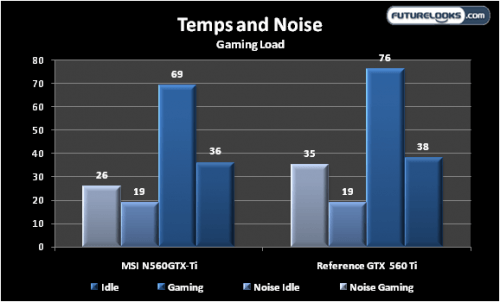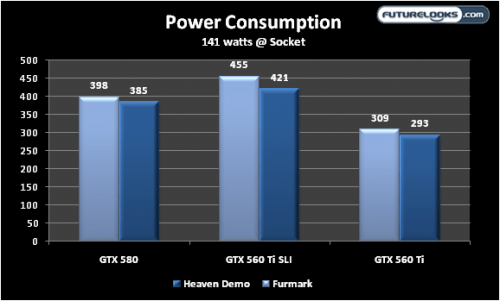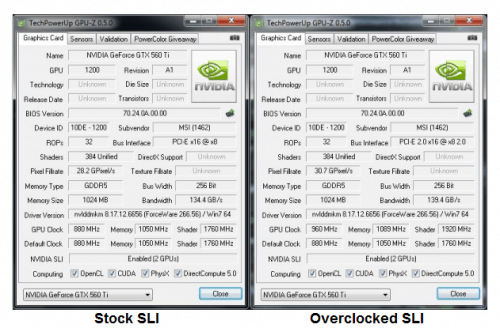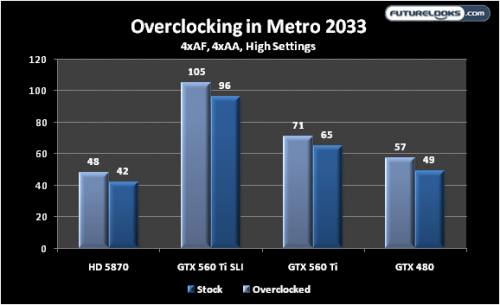A Look at MSI’s Non-Reference N560GTX-Ti Cooling Solution vs Reference
In these tests, I use Unigine’s benchmark which acts as a very good representation of intense gaming. The benchmark was repeated at the highest DX11 tests several times. Both video cards were left to control themselves. The Antec P183 case’s fans were left on low to represent an average computer case being used.

I was expecting much higher temps given the 42 CFM air flow of the case while when running 3D given the higher GPU frequencies. Basically, between the extra heat pipe and GPU updates, both cards’ coolers do a decent job. But, the Twin FrozrII cooler is still quieter and cooler. We’re very interested in seeing what some other partner’s have come up with in the labs later on.
Power Consumption Under 500 Watts
During my testing, I had my test system plugged into a Seasonic Power Angel and kept an eye on the wattage pulled from the socket. Hibernation and Sleep mode weren’t turned on during all the work. Furmark and Unigine Heaven demo was again used to test the power consumption limits of the card(s). Unigine is a very video intensive demo more so than most games. Furmark pushes the cards much harder like @Home Folding folks no doubt understand.

While sitting idle at desktop, the system pulled a meager 141 watts. In single card mode, the system pulled about 295 watts. In SLI mode, the system consumed 421 watts. Furmark pushed the video cards further reaching an average of 457 watts. This means our cards are consuming a max of about 158 watts which is inline with specifications. This also means that gamers wanting to run SLI can get away with using a quality 80Plus 750 watt power supply. The 500 Watt minimum requirement just will not cut it.
Overclocking the GTX 560 Ti
First, I worked at overclocking the Ti in a single card capacity using MSI Afterburner; a utility that works on all cards not just their own. The GPU clock just reached 970 MHZ and Shader topped out at 1935 MHz. Frame rates went up a few points across the titles tested. This was impressive and all on a stock Ti GPU, but I’m a fiend for SLI overclocking.

After pairing up the cards, the configuration’s max overclock was 960 MHz GPU Clock (1089 MHz Memory) and 1920 MHz Shader clock. Frame rates were a bit higher and more noticeable in various titles with a healthy average increase experienced in Metro 2033. Any higher and the voltage needed to be increased just a little more than I typically like.

It might not be all that great, but it makes a bigger difference if you’re using resolutions above 1920 x 1200. Sometimes that extra 8 to 12 frames makes all the difference in a challenging scene.
The Sweetest Choice for Gamers in 2011
Based on all we’ve witnessed, the NVIDIA GeForce GTX 560 Ti is a light weight, strong and high performance video card that lives up to its Ti designation which represents a metal with similar characteristics. While DirectX 9 and 10 performance is all around great, it’s the DirectX 11 performance that is probably the most impressive feature of this new GPU. It’s in those benchmarks that this card truly shows off what it is capable of at such an affordable price.
At the end of the day, the NVIDIA GeForce GTX 560 Ti is a great bang for buck choice for gamers wanting to play at high resolutions well up to 1920 x 1200. Anyone using slightly smaller monitors will be even more impressed as you begin to maximize every possible setting including PhysX. Best of all is the aggressive $249 US price tag at launch which is only $20 more than the GTX 460 1GB when it launched. And while the GTX 460 was never the GPU to push SLI, NVIDIA really did tune this one to work better as a pair and they have let us know it here today.
After seeing what the MSI N560GTX-Ti with the Twin Frozr II cooler can do, we’re really looking forward to seeing what the next batch of GTX 560 Ti cards can do in our testing labs.
Love This Review? Hate This Review? Leave a Comment Below!
